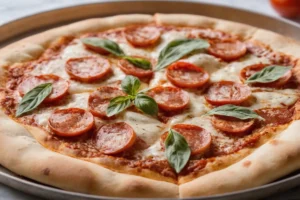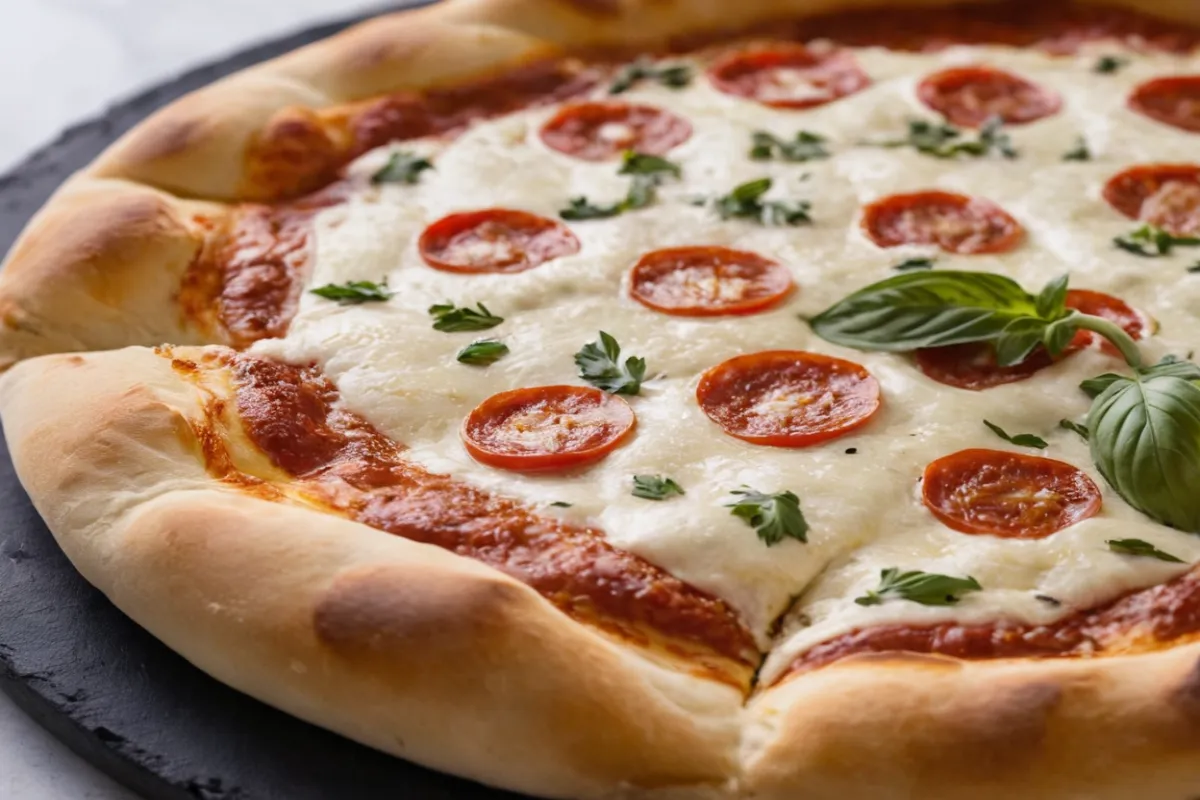When it comes to making the perfect pizza, one of the most critical elements is the dough. Whether you’re a seasoned pizza enthusiast or a beginner in the world of homemade pizza, getting your dough right can be the difference between a good pizza and an extraordinary one. For those using the Ooni pizza oven, which can reach temperatures over 900°F, a specific pizza dough recipe is needed to create that ideal Neapolitan-style crust. This blog will guide you through the perfect Ooni pizza dough recipe, with tips, insights, and all the information you need to master pizza-making at home.
Ingredients for Ooni Pizza Dough
A great pizza starts with simple, high-quality ingredients. Here’s what you need:
- Flour: 500g (around 3 ¼ cups) of strong white bread flour. The protein content should be at least 12%, which is ideal for gluten development. The flour’s quality will affect your dough’s elasticity, and using strong white bread flour is crucial to get the signature chewiness of Neapolitan pizza.
- Water: 325g (1 ½ cups) of lukewarm water. Water temperature is key here, helping to activate the yeast while being cool enough to allow for a slow rise, which develops complex flavors in the dough.
- Yeast: 7g (1 packet or 2 tsp) of active dry yeast. Yeast helps your dough rise, creating those lovely air pockets and a light texture.
- Salt: 10g (2 tsp) of fine sea salt. Salt isn’t just for flavor; it also strengthens the gluten structure in the dough.
- Olive Oil: Optional but recommended. A tablespoon of olive oil can add depth to the flavor and improve the dough’s handling.
Step-by-Step Process: Making the Dough
Now, let’s break down the process step by step. This recipe will take around 24 hours, so prepare ahead for pizza day!
- Mixing the Dough: In a large mixing bowl, combine the flour, salt, and yeast. Slowly pour in the lukewarm water while mixing with a wooden spoon or your hands. Continue mixing until you form a shaggy dough. At this stage, you may add olive oil if you wish, which will help create a slightly softer dough with a richer taste.
- Kneading the Dough: Transfer the dough onto a lightly floured surface. Knead by hand for about 10 minutes, until the dough becomes smooth and elastic. You can also use a stand mixer fitted with a dough hook, kneading on medium speed for 5-7 minutes. The goal is to develop the gluten network, which will give the dough its structure and stretchiness.
- First Rise: Shape the dough into a ball and place it in a lightly oiled bowl. Cover with a damp cloth or plastic wrap. Let the dough rest at room temperature for about 2 hours or until it doubles in size. This first rise is essential for flavor development.
- Cold Fermentation: After the dough has risen, punch it down to release excess air. Divide the dough into 3-4 equal portions (depending on the size of pizzas you want). Shape each portion into a ball and place them in individual containers or on a baking sheet, covered. Refrigerate for at least 18 hours or up to 72 hours. This slow fermentation process allows for deeper flavor and a more complex crust.
- Shaping the Pizza: Once the dough is fully fermented, take it out of the refrigerator at least 1 hour before you plan to bake it, allowing it to come to room temperature. Gently press each dough ball into a round shape, starting from the center and working your way outward. Avoid using a rolling pin, as you want to keep as much air in the dough as possible for a light, airy crust.
- Baking in the Ooni: Preheat your Ooni pizza oven to the highest setting (900°F or higher). Stretch the dough further into a 10-12 inch pizza base. Add your favorite toppings, but remember, less is more when it comes to authentic Neapolitan pizza. Slide the pizza onto a well-floured pizza peel and then into the oven. Cook for about 60-90 seconds, turning the pizza regularly to ensure even cooking.
The Science Behind the Perfect Dough
Pizza dough is simple at first glance, but the science behind it is fascinating. The key to great dough is gluten development, yeast fermentation, and hydration levels.
- Gluten Development: Gluten is the protein in flour that forms long strands when mixed with water. Kneading helps align these strands into a network, which gives dough its stretchy, elastic quality. This is crucial when baking at high temperatures like in the Ooni oven, as the dough needs to expand rapidly without tearing.
- Yeast Fermentation: Yeast feeds on the sugars in the flour, producing carbon dioxide and alcohol as byproducts. The carbon dioxide gets trapped in the gluten network, creating air pockets that give pizza its light, airy texture. Slow fermentation allows the dough to develop more complex flavors, which is why the 18-72 hour cold fermentation period is so important.
- Hydration Levels: The amount of water in your dough affects its texture and ease of handling. Higher hydration doughs (those with more water) tend to be more difficult to work with but produce a lighter, airier crust, which is ideal for Neapolitan-style pizza.
Tips for Success
- Choosing the Right Flour: The flour you use will have a huge impact on the final dough. Caputo 00 flour, known for its fine grind and high protein content, is considered the gold standard for Neapolitan pizza. However, if you can’t find it, strong white bread flour will also work well.
- Managing Dough Hydration: If you find the dough too sticky to handle, lightly flour your hands and work surface, but avoid adding too much flour to the dough itself, as this can lead to a denser crust.
- Perfecting the Stretch: Practice makes perfect when it comes to shaping your dough. Start gently and work evenly from the center outwards, preserving the edges to ensure a nice puffy crust.
- Cooking at High Temperatures: The Ooni oven’s high temperatures mimic the conditions of traditional wood-fired pizza ovens, but it also means you need to keep a close eye on your pizza. Rotate it every 15-20 seconds to ensure it cooks evenly.
Ingredient Quality and Sourcing
In any recipe, especially pizza dough, ingredient quality matters. Let’s explore why each ingredient is so vital:
- Flour Quality: Using high-quality flour is key for pizza dough. Lower protein flours won’t create the same gluten structure, which means your dough will lack elasticity. Look for flours with at least 12% protein for the best results.
- Water Source: While water might seem like a minor ingredient, its quality can make a difference. If your tap water is overly chlorinated or hard, it can inhibit yeast activity. Using filtered water helps ensure consistent results.
- Fresh Yeast vs. Dry Yeast: Some people prefer using fresh yeast, which is more perishable but often considered superior in flavor. Active dry yeast, however, is more accessible and has a longer shelf life, making it convenient for home use. Make sure your yeast is fresh and properly activated before mixing it into your dough.
Regional Variations of Pizza Dough

Different regions of the world have their own takes on pizza dough. While the Ooni pizza dough recipe follows the Neapolitan tradition, it’s interesting to look at other regional styles:
- New York-Style Pizza Dough: This dough has more sugar and oil than traditional Neapolitan dough, which allows it to develop a crispy yet pliable texture. The dough is often rolled out thinner and baked at lower temperatures for a longer period.
- Sicilian Pizza Dough: Sicilian dough is thicker and more bread-like. It’s usually baked in rectangular pans and has a heavier crust due to its higher hydration and longer bake time.
- Chicago Deep Dish: This style uses a dough similar to a pie crust, often with cornmeal added for extra crunch. It’s pressed into a deep pan, filled with cheese and toppings, and baked for an extended period.
Cultural Significance of Pizza
Pizza is not just a dish; it’s a cultural phenomenon. Originally from Naples, Italy, pizza has spread across the globe, evolving into various forms while retaining its roots in simplicity and communal dining.
In Naples, pizza-making is considered an art, with UNESCO recognizing the Neapolitan pizza-making process as part of the world’s “intangible cultural heritage.” This recognition highlights pizza’s role in bringing people together and celebrating tradition.
Using an Ooni pizza oven allows home cooks to tap into this heritage by creating authentic-style pizzas right in their backyard. By perfecting the dough, you’re not just making food – you’re participating in a centuries-old tradition of craftsmanship and communal dining.
Pairing Your Pizza with Sides and Drinks
The beauty of pizza is how well it pairs with a variety of sides and drinks. Here are some classic pairings:
- Salads: A simple green salad with a tangy vinaigrette cuts through the richness of the cheese and toppings, balancing the meal.
- Wines: Neapolitan Ooni Pizza Dough Recipe pairs beautifully with light, fruity red wines like a Chianti or a Sangiovese. These wines have enough acidity to complement the tomato sauce without overwhelming the flavors.
- Craft Beer: The malty sweetness of craft beer can balance out the savory, sometimes salty elements of pizza, while the carbonation helps cleanse the palate.

